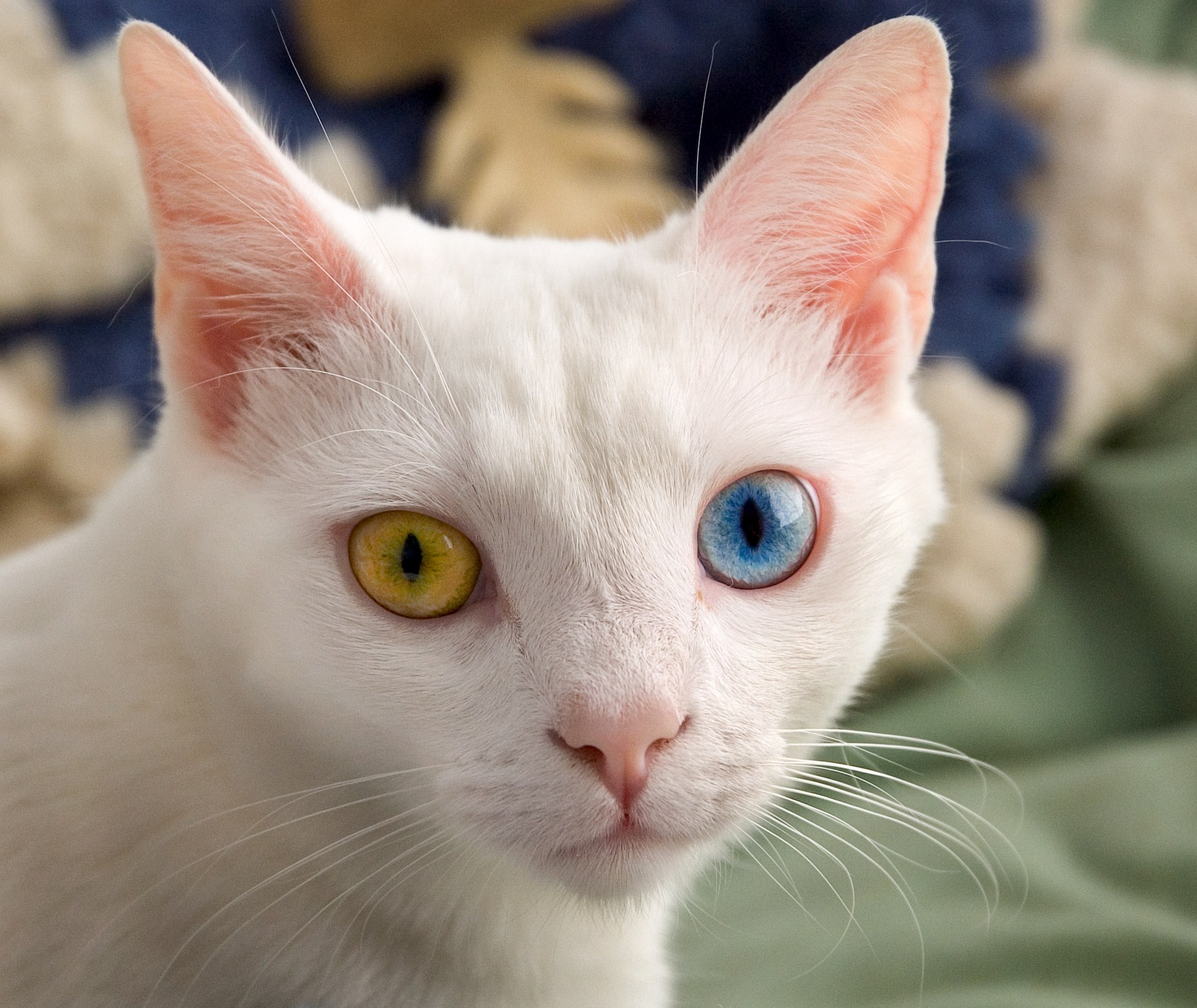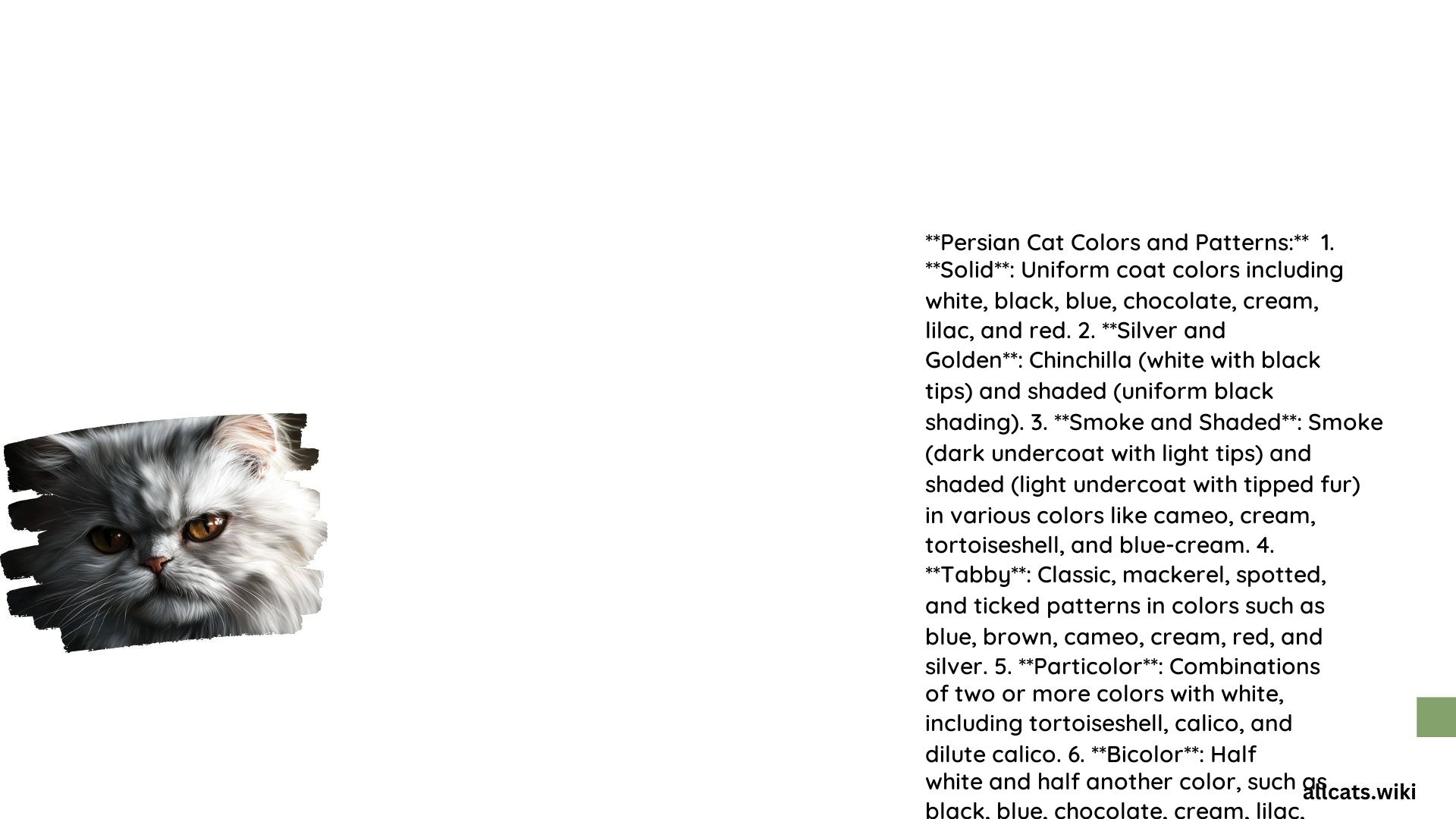Identifying the various colors and patterns of Persian cats can be a fascinating and rewarding experience for cat enthusiasts. From the classic solid colors to the more unique bi-color and tabby patterns, each Persian cat’s coat is a unique work of art. In this comprehensive guide, we will explore the genetic foundations, potential breeding outcomes, and examples of the diverse range of Persian cat colors and patterns.
What are the Potential Outcomes When Breeding a Solid Persian Cat with a Bi-Color Persian Cat?

Genetic Explanation:
– Solid Color Genetics: Solid colors in Persian cats are determined by the interaction of two types of melanin: eumelanin (black and dark brown) and pheomelanin (red and yellow). Each color has a specific genetic code, but when breeding, we focus on the dominant and recessive traits.
– Bi-Color Genetics: Bi-color cats have a combination of white and another color. The white color is usually the result of the extreme piebald gene, which masks other colors on parts of the body.
Potential Outcomes:
– When breeding a solid Persian cat with a bi-color Persian cat, the offspring can inherit a combination of genes that may result in solid, bi-color, or other patterns.
– Solid Offspring: If the bi-color parent contributes a solid color gene (not masked by the piebald gene), the offspring can be solid.
– Bi-Color Offspring: If the bi-color parent contributes the piebald gene, the offspring can be bi-color.
– Other Patterns: Depending on the interaction of genes, other patterns like tabby or smoke can also appear if the parents carry these genes.
Example:
– Breeding a Black Solid with a Black and White Bi-Color:
– Possible outcomes: Black solid, Black and White bi-color, or potentially other patterns if hidden genes are present.
How Can Breeding a Smoke and White Persian Cat with a Solid Persian Cat Affect the Offspring?

Genetic Explanation:
– Smoke and White Genetics: Smoke colors are the result of a specific type of tipping that creates a smoky effect. The white in smoke and white cats is due to the piebald gene.
– Solid Color Genetics: As mentioned earlier, solid colors are determined by the interaction of melanin types.
Potential Outcomes:
– When breeding a smoke and white Persian cat with a solid Persian cat, the offspring can inherit a combination of genes that result in various patterns.
– Smoke and White Offspring: If the smoke and white parent contributes the piebald gene and the tipping gene, the offspring can be smoke and white.
– Solid Offspring: If the solid parent contributes a dominant solid color gene, the offspring can be solid.
– Other Patterns: Depending on the interaction of genes, other patterns like tabby or bi-color can also appear.
Example:
– Breeding a Blue Smoke and White with a Black Solid:
– Possible outcomes: Blue smoke and white, Black solid, Blue solid, or potentially other patterns if hidden genes are present.
What is the Probability of Getting a Tabby Persian Kitten from a Bi-Color Persian Cat and a Solid Persian Cat?
Genetic Explanation:
– Tabby Genetics: Tabby patterns are determined by the agouti gene, which controls the distribution of melanin. The agouti gene can be dominant (A) or recessive (a).
– Bi-Color and Solid Genetics: As explained earlier, bi-color cats have the piebald gene, and solid cats have specific melanin interactions.
Probability:
– The probability of getting a tabby Persian kitten depends on whether the parents carry the agouti gene.
– If Both Parents Carry the Agouti Gene: There is a higher chance of tabby offspring, but it also depends on the interaction with other genes like the piebald gene in bi-color cats.
– If Only One Parent Carries the Agouti Gene: The probability is lower but still possible if the other parent is a carrier of the recessive agouti gene.
Example:
– Breeding a Black and White Bi-Color with a Black Solid:
– If the bi-color parent is a carrier of the agouti gene (Aa), and the solid parent is also a carrier (Aa), there is a 25% chance of tabby offspring, 50% chance of non-tabby carriers, and 25% chance of non-tabby non-carriers.
What are the Potential Outcomes When Breeding a Blue Persian Cat with a Cream Persian Cat?
Genetic Explanation:
– Blue and Cream Genetics: Blue is a dilute version of black, and cream is a dilute version of red. These colors are determined by the interaction of melanin types and dilution genes.
– Genetic Combinations: When breeding a blue Persian cat with a cream Persian cat, the offspring can inherit a combination of these genes.
Potential Outcomes:
– Blue-Cream Offspring: The offspring can be blue-cream bi-color or solid blue-cream.
– Dilute Colors: Depending on the dilution genes, the offspring can also be lighter versions of these colors.
– Other Patterns: If hidden genes are present, other patterns like tabby or smoke can also appear.
Example:
– Breeding a Blue Solid with a Cream Solid:
– Possible outcomes: Blue-cream bi-color, Blue solid, Cream solid, or potentially other patterns if hidden genes are present.
How Can Breeding a Bi-Color Persian Father with a Solid Persian Mother Affect the Offspring?
Genetic Explanation:
– Bi-Color and Solid Genetics: As explained earlier, bi-color cats have the piebald gene, and solid cats have specific melanin interactions.
– Genetic Traits: The offspring will inherit a combination of these genes, determining their coat pattern.
Potential Outcomes:
– Bi-Color Offspring: If the bi-color father contributes the piebald gene, the offspring can be bi-color.
– Solid Offspring: If the solid mother contributes a dominant solid color gene, the offspring can be solid.
– Other Patterns: Depending on the interaction of genes, other patterns like tabby or smoke can also appear.
Example:
– Breeding a Black and White Bi-Color Father with a Black Solid Mother:
– Possible outcomes: Black and White bi-color, Black solid, or potentially other patterns if hidden genes are present.
What are the Potential Outcomes When Breeding a Tabby Persian Father with a Pointed Persian Mother?
Genetic Explanation:
– Tabby Genetics: Tabby patterns are determined by the agouti gene.
– Pointed Genetics: Pointed patterns are determined by the interaction of the pointed gene with other color genes.
– Genetic Possibilities: When breeding a tabby Persian father with a pointed Persian mother, the offspring can inherit a combination of these genes.
Potential Outcomes:
– Tabby-Pointed Offspring: The offspring can exhibit a combination of tabby and pointed patterns.
– Solid or Bi-Color Offspring: Depending on the interaction of genes, the offspring can also be solid or bi-color.
– Other Patterns: If hidden genes are present, other patterns like smoke or shaded can also appear.
Example:
– Breeding a Classic Tabby Father with a Himalayan Pointed Mother:
– Possible outcomes: Tabby-pointed, Solid, Bi-color, or potentially other patterns if hidden genes are present.
References
- Persian Cat Color Calculator – Pelaqita Persians
- How to Identify Types of Persian Cats – AnimalWised
- Persian – Cat Fanciers’ Association
- Persian Cat Color Names: A Comprehensive Guide – Naming Cat
- 18 Persian Cat Colors & Patterns – Catster.
